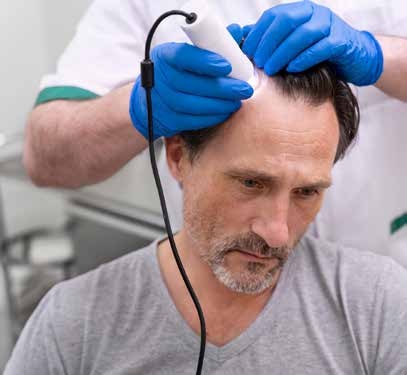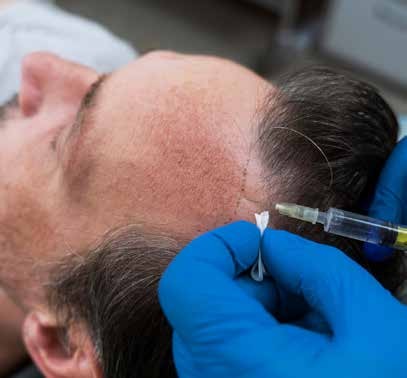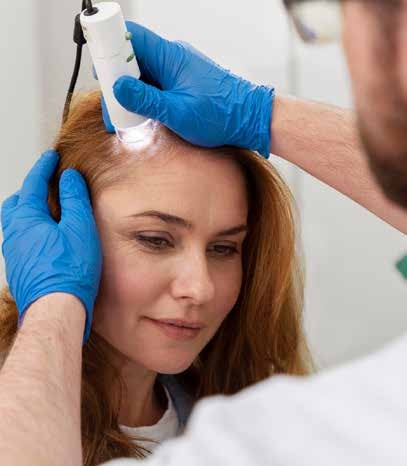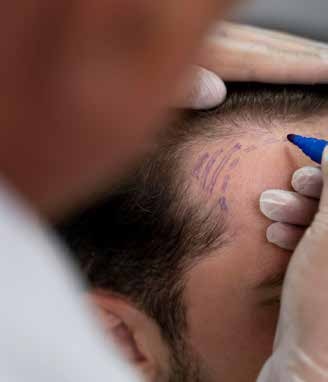Follicle Focus
Shriyal Sethumadhavan delves into hair loss challenges by exploring clinical complexities and progressive approaches through conversations with expert dermatologists and surgeons.
H air loss presents a spectrum of challenges for aesthetic dermatologists and trichologists. Differentiating between diverse conditions demands detailed analysis, considering factors like pattern, texture, and related symptoms. Variations in etiology further complicate diagnosis – separating genetic, hormonal, or stressinduced causes requires extensive expertise. Also, distinguishing between alopecia types, be it androgenetic, alopecia areata, or telogen effluvium, necessitates astute observation and often supplementary tests. Additionally, underlying health issues along with hair loss result in an added layer of complexity. Such a scenario demands a blend of clinical acumen, cutting-edge diagnostic tools, and a deep understanding of dermatology.
Complexities and challenges
Aesthetic dermatologists and trichologists encounter various challenges in diagnosing hair loss, especially in distinguishing between different conditions or causes.
As Dr Rinky Kapoor, Consultant Dermatologist, Cosmetic Dermatologist, The Esthetic Clinics, says, “Hair loss is multifactorial in origin. It stems from a plethora of factors such as genetics, hormonal discrepancies, nutritional deficiencies, environmental influences, chemotherapeutic drugs, and any underlying medical conditions. For something so diverse in etiology, the main challenge is to pinpoint any one cause!” She adds that the key is to take a detailed history and conduct a thorough clinical examination to identify early signs. For instance, progressive thinning of hair is observed in patterned hair loss, psoriasis, or seborrheic dermatitis, while acute excessive shedding occurs in Telogen effluvium, Anagen effluvium, or active stages of scarring alopecia. Dr Rinky emphasises the importance of examining beyond the scalp occasionally, as many doctors might overlook this vital part of the examination. She lists it as imperative for practitioners to inquire about their patients’ hair loss, diet, lifestyle, family history, and closely examine the scalp – “you will find your answer.” One needs to be trained to evaluate subtle clinical signs, pick up hints in the history, understand hair loss patterns, identify hair types during clinical examination, and sometimes use technology to reach a clinical conclusion. She notes, “Many times, patients have consulted multiple doctors, undergone multiple treatments, and consulted ‘Doctor Google’, which distorts the original picture and adds confusion and bias. The challenges are numerous, but they can certainly be overcome.”

Dr Aseem Sharma, Consultant Dermatologist, Skin Saga, agrees, stating that diagnosing hair loss demands a comprehensive understanding of the various types and causes. He outlines key complexities and challenges encountered by aesthetic dermatologists and trichologists in diagnosing hair loss:
• Variety of hair loss types: Different types of hair loss have unique characteristics and causes, demanding familiarity for accurate diagnosis.
• Similar symptoms: Many types of hair loss share common symptoms, making it challenging to differentiate between conditions or causes.
• Multiple causes: Hair loss can result from various factors, requiring identification of the underlying cause for effective treatment.
• Misdiagnosis: This common issue in hair loss diagnosis necessitates thorough examinations and the use of dermoscopy.
Dr Sahil Mrigpuri, MD Dermatology (P.G.I Chandigarh), Medical Superintendent, Consultant Neelkanth Hospital, Himachal Pradesh, also confirms that challenges may arise from non-evident clinical signs and symptoms, inadequate patient history, or unavailability of trichoscopy. He emphasises the necessity of trichoscopy, with scalp biopsy as a crucial step whenever trichoscopy results are doubtful.
Dr Vinay Chouksey, Chief Hair Transplant Surgeon, Wow Cosmetology Centre, Juhu, and Richfeel Hairforever, underscores the importance of meticulous history-taking in this diagnostic process, highlighting the significance of examining beyond the scalp occasionally.
And Dr Viral Desai, Cosmetic & Plastic Surgeon; Co-founder and Medical Director, DHI India; Medical Director, CPLSS, Desai Hospitals and Sarla Hospitals; Founder and Medical Director, Skin Vibes Clinic, emphasises the difficulty in distinguishing between different conditions or causes and addressing the emotional distress caused by hair loss. He emphasises the importance of comprehensive evaluations by dermatologists and their expertise in diagnosing hair loss accurately. “While both dermatologists and trichologists can be sources of support for hair and scalp issues, dermatologists are generally considered the best option for diagnosing hair loss due to their clinical training and expertise.”
PRP and regenerative therapies In recent years, platelet-rich plasma (PRP) and regenerative therapies have evolved as potential treatment options for hair loss concerns.
PRP has been around for the better part of the past few decades. It has been tried in every possible way – as a combination with other treatments, through different administration techniques, and with tedious efforts to optimise the concentration of growth factors it may derive. “Presently,” Dr Rinky says, “PRP is present in every nook and corner of trichology practices, and there is nothing new to say. There are now more refined techniques for concentrating growth factors available to enhance the yield of platelet-derived factors.” She adds that what is truly revolutionising the hair industry is the advent of newer regenerative therapies that have recently stormed the market. Stem cell therapies, exosome treatments, and biomimetic polypeptides are emerging as the next treatment modalities for hair. “These formulations aim to stimulate the signalling pathways associated with hair follicle development and maintenance and appear to be more precisely targeted at a molecular level. These non-surgical modalities are not only being used standalone but also being studied in combination with surgical modalities like hair transplants to aid better results.”
While exosomes and stem cell therapies are being explored for their regenerative properties to enhance the natural hair growth cycle, Dr Rinky highlights the importance of understanding that cell-based therapies often raise safety concerns due to the lack of current regulatory approvals.

Dr Aseem says, “PRP therapy involves injecting a patient’s own blood plasma, which is rich in platelets, into the scalp to stimulate hair growth. Regenerative therapies involve isolating stem cells from a patient’s fat via liposuction, concentrating and activating them, and then reinjecting them into areas of hair loss on the scalp, similar to utilising the entire extracellular matrix for hair regeneration.” Recent research has shown that both PRPand regenerative therapies can be effective in treating hair loss. While both PRP and regenerative therapies have demonstrated positive results for hair growth, stem cells have some potential advantages over platelets. Dr Aseem adds, “Stem cells have higher concentrations of regenerative cellular secretions compared to PRP, and they have the ability to differentiate into other cell types, including follicle and dermal papilla cells. However, PRP treatments are generally more accessible and affordable than regenerative therapies. In conclusion, PRP and regenerative therapies have significantly evolved in recent years to address hair loss concerns. Both treatments have demonstrated positive results for hair growth, and they represent promising alternatives to traditional hair loss medications like minoxidil and finasteride. Further research is necessary to develop effective treatment protocols and improve the standardisation of hair loss diagnosis and treatment.”
Agreeing that PRP and regenerative treatments have revolutionised the industry, Dr Sahil mentions, “The response to PRP and regenerative medicine is generally faster compared to classical medicines. They are safe, promising, and represent the future of trichology science. Additionally, they are significantly safer and instil greater patient confidence in treatment.”
For Dr Vinay, “PRP has become an integral part of trichology practice. Newer modalities like Regenera, SVF, and nanofat appear promising. Mesotherapy with growth factors and drugs also proves effective.”

Elaborating on PRP, Dr Viral says, “It is a three-step medical treatment in which a person’s blood is drawn, processed, and then injected into the scalp. Platelets in PRP promote cell growth and regeneration. The increased concentration of growth factors in platelet-rich plasma may stimulate or speed up the healing process, shortening healing time for injuries, decreasing pain, and even encouraging hair growth.” Most research on PRP for hair loss has focused on its use to treat androgenetic alopecia (AGA), which is a condition that can affect both men and women. PRP can be used as a new therapeutic option for hair loss, including androgenetic alopecia and female pattern hair loss, either as a monotherapy or an adjuvant to conventional therapy or hair transplantation. Dr Viral adds, “PRP can also be combined with hair transplantation, giving significantly improved density and quality of hair growth, reducing the catagen loss of transplanted hair, enabling early skin recovery, and facilitating the faster appearance of new anagen hair in FUE transplant patients.”
While more research is needed, PRP treatment for hair loss may help promote and maintain hair growth, and it is considered a safe and effective treatment option against hair loss.
Latest treatments and technologies
We inquired about the most recent treatments and technologies available at their clinics from the doctors.
Dr Sahil emphasised the utilisation of exosomes as his latest treatment. “These are extracellular vesicles crucial for intercellular communication and transporting bioactive molecules. Stem cell-derived exosomes contain mRNA and play a vital role in the mechanism of hair loss.”
Dr Vinay mentioned QR678 and mesotherapy, as well as Regenera Activa and Racine Pro.
As a dermatologist deeply involved in hair practices, Dr Rinky values treatments that are safe, effective, well-researched, and evidence-backed for her patients. She states, “I prioritise treatments that are time and cost-effective, do not require significant capital investment, are painless, sustainable, free of biohazards, and offer enduring results.” One such treatment that fits these criteria for her is QR678 Neo, a peptide-driven formulation. According to her, “QR678 Neo, a patented therapy with patents in the USA and India, comprises six biomimetic polypeptides specifically targeting hair loss for promoting regrowth. It has been studied for numerous hair loss indications like Androgenetic Alopecia, Alopecia Areata, Telogen Effluvium, Chemotherapy-Induced Alopecia, Seborrheic Dermatitis, and PCOS-Induced hair loss. QR678 Neo is a swift, effective, and painless therapy with minimal side effects and no downtime, beneficial for both patients and doctors!” However, it does not replace surgical therapies where transplants are necessary. The right treatment must match the right patient for optimal results.

Dr Aseem shared his list of new therapies:
• “PRP therapy: It involves injecting a patient’s blood plasma, rich in platelets, into the scalp to stimulate hair growth. We also perform newer concentrated growth factors and second-generation PRP routinely at our clinic.
• Regenerative therapies: These involve isolating stem cells from a patient’s fat through liposuction, concentrating, activating them, and reinjecting them into areas of hair loss on the scalp.
• Botulinum toxin: Used to enhance vascular supply to the hair follicle by relaxing the galea.
• Radial PDO Mono Threads: Applied in resistant patchy scalp areas.
• Humanised growth factors with and without cytokines for enhanced hair growth and immune-boosting.
• Low-level laser therapy (LLLT): It uses low-level lasers to stimulate hair growth effectively in androgenetic alopecia patients2.
• Microneedling: A method employing tiny needles to stimulate collagen and elastin production in the scalp, promoting hair growth. Fractional MNRF and fraction erbium glass lasers enhance this process.
• Nutraceuticals: Biotin and zinc among others effectively promote hair growth and prevent hair loss.
• Traditional medications: Widely used minoxidil and finasteride for hair loss treatment. Newer non-invasive treatments like PRP, LLLT, microneedling, fractional energy-based devices, and nutraceuticals are safe and effective. They can be combined with traditional medications like minoxidil or oral finasteride.” Dr Viral discusses some of the latest advancements used atCPLSS:
• “Follicular Unit Extraction (FUE) and Direct Hair Implantation (DHI): Techniques refined over time and evolving with technology and medical knowledge.
• Advanced Laser Therapy: Stimulates hair follicles, aiding growth and density.
• PRP Therapy: A three-step treatment promoting cell growth, healing, and hair growth.
• Laser Light Therapy: Uses light across specific wavelengths to encourage tissue regeneration and repair.
• Exosomes: Produced by mesenchymal stem cells, playing a role in cell communication, homeostasis, differentiation, and organogenesis. They hold promise in hair morphogenesis and regeneration, containing growth factors vital for hair follicle growth, angiogenesis stimulation, hair growth cycle regulation, and antiinflammatory effects.”
While these treatments and technologies are promising, only a medical professional can ascertain the most suitable treatment for specific types of hair loss.
Looking ahead…
The integration of recent advancements in clinical practice for treating various forms of hair loss holds immense promise. The field of hair science is evolving more now than ever.
The advent of regenerative therapies for hair loss – be it polypeptides, exosomes, or stem cells – has dramatically altered the management of alopecia. Hair loss has emerged as a more frequently occurring problem in recent times, but its prognosis has improved too.
“There is a shift in current trends towards more non-invasive and injectable therapies,” says Dr Rinky. The existing modalities, Minoxidil and Finasteride, have formed the backbone of medical treatments for alopecia for decades. She believes the
amalgamation of these treatments with newer regenerative therapies is what we will get to see over the coming years. “These will be supported by gene mapping techniques (work on which is already on), which would probably be able to provide customised treatment solutions and perhaps preventive solutions too for hair loss.”
“Our understanding of hair loss pathogenesis and regenerative medicine will revolutionise the horizon,” says Dr Sahil. He adds, “The more we comprehend the mechanisms of hair loss in different conditions, the better we can target the cause at various levels for improved results. Regenerative medicine, including PRP, SVF, stem cell mesotherapy, and exosomes, offers safe and faster treatment options.”
Dr Vinay emphasises regenerative therapies, a nutritional approach to hair restoration, and anti-inflammatory diets as essential strategies for regaining hair.

As a dermatologist, Dr Aseem anticipates that the integration of these advancements in clinical practice for treating various forms of hair loss will continue to evolve in the coming years. “With the increasing popularity of non-invasive treatments like PRP therapy, regenerative therapies, LLLT, microneedling, and nutraceuticals, we can expect to see more research and development in these areas.” In addition, several promising developments on the horizon could revolutionise these treatment modalities. Dr Aseem shares, for example, “scientists have discovered that a type of microRNA may help treat hair loss by softening hair follicles, which naturally become stiffer as we age and contribute to hair loss. This type of microRNA could lead to the development of a new treatment for baldness.” He also highlights the use of JAK inhibitors to treat alopecia areata, a form of sudden hair loss, stating, “Clinical trials have shown that JAK inhibitors are effective in treating moderate-to-severe alopecia areata, and several drugs are currently approved or moving toward approval. Exosomes are another area teeming with research on how cellular signals can be transferred from healthy cells to unhealthy cells, simplistically. In conclusion, we can expect to see more research and development in noninvasive treatments like PRP therapy, regenerative therapies, LLLT, microneedling, and nutraceuticals, as well as promising developments like microRNA and JAK inhibitors.” He concludes that further research is needed to develop effective treatment protocols and improve the standardisation of hair loss diagnosis and treatment.
“Techniques such as FUE, DHI, and Advanced Laser Therapy have undergone significant refinements, showcasing their efficacy in promoting hair growth and increasing density,” says Dr Viral, adding, “PRP Therapy and Laser Light Therapy are noteworthy contributors. With its ability to stimulate cell growth and regeneration, PRP has become a versatile tool, either as a standalone therapy or in conjunction with conventional treatments like hair transplantation. Laser Light Therapy, using specific wavelengths, effectively stimulates tissue regeneration, contributing to the overall improvement of hair density.” He mentions Exosomes as “emerging as a research focus and revolutionary to hair loss treatment.” These extracellular vesicles, derived from mesenchymal stem cells, contain growth factors crucial for hair follicle growth, angiogenesis stimulation, and regulation of the hair growth cycle. The potential of exosomes in hair morphogenesis and regeneration opens up new possibilities for combating hair loss.
As we look ahead, the horizon holds exciting prospects. Ongoing research into these modalities, especially using exosomes, presents opportunities for even more effective and targeted treatments. The understanding of cellular communication, homeostasis, and differentiation continues to evolve, paving the way for innovations that could revolutionise how medical experts address hair loss.